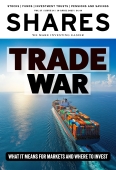Archived article
Please note that tax, investment, pension and ISA rules can change and the information and any views contained in this article may now be inaccurate.
Why you should buy ASML while there is widespread market weakness

ASML (ASML:AMS) €570
Market cap: €194 billion
History tells us that when equities go into freefall investors should buy the market. It’s a point Shares makes more forcefully in our other Great Ideas selection this week, the Fidelity Index World (BJS8SJ3) fund.
Pitching the case to buy chip tech equipment maker ASML (ASML:AMS) is an even bolder call, you might argue, but one that we believe in strongly. Before we get into the detailed rationale, let’s make sure readers understand the company we are writing about.
We have said it many times before and it’s worth saying again… Dutch firm ASML really is a big deal in the chips space. The advanced lithography machines it makes cost a fortune and are crucial in semiconductor fabrication process.
A GLOBAL RARITY
Put bluntly, it is the only company in the world capable of manufacturing the EUV (extreme ultraviolet) tools needed for printing bleeding edge, complex semiconductor chips driving the modern world, giving it a unique place in the complex AI (artificial intelligence), cloud computing and wider semiconductors ecosystem.
ASML’s giant machines, arguably the most important piece of equipment used by companies like Taiwan Semiconductor Manufacturing (TSM:NYSE), Samsung Electronics (SMSD) (the London-listed GDRs). Intel (INTC:NASDAQ) and every chip maker.
These EUV advanced lithography machines take months to build, install and qualify for production in chip foundries that cost tens of billions of dollars to build and run.
The operators of these facilities know that they need to be running that gear flat out, 24 hours a day, to give themselves a chance of making a return on the massive upfront investment, and that means customers place orders with ASML typically when they’re confident that they’ll have enough demand to keep the machines busy as long as a year in the future, an element of crystal ball gazing that leads to miscalculations.
WHY INVEST NOW?
Which brings us neatly on to the why now part of the debate. For simplicity’s sake, we’ve boiled it down to three core issues: tariffs and recession, US chip onshoring, and valuation.
President Trump wants more stuff made in America, and particularly advanced technology that is powering the AI revolution to retain some sort of hegemony and control. Chips are a perfect example. Its why top levels negotiations have already taken place with TSMC, the world’s biggest chip manufacturer, and others, and why Trump is so keen to find a ‘friendly’ partner for struggling Intel.
The president’s tariffs as they stand will harm the industry in the short-term, and industry which is sensitive to economic prosperity, or lack thereof, so if the US does plunge into recession, expect more volatility. Yet the flip side is the huge investment in new US-based capacity already in the pipeline, and likely to accelerate further as time ticks by, to significantly increase fabrication facilities Stateside.
These foundries take years to build from scratch, up to six or seven, so while the short-term outlook for the industry will remain volatile, the ground is being seeded for future growth like never before. This increased US onshoring should see demand for ASML’s most advanced EUV machines steadily increase over the coming years to meet this new fabs capacity. Add in foundry capacity expansion across ASML’s home EU markets, and that it is still allowed to sell older EUV machines to China, you start to get a sense of how well placed the Dutch firm is to prosper on a medium-to-longer run view.
TWO DECADES DEEP DISCOUNT
Which brings us on to valuation. ASML shares have tanked following Trump’s ‘Liberation Day’ tariffs bombshell, seeing a double-digit decline in the past two weeks. They are down from around €700 at the start of 2025 and have fallen from nearly €1,000 over the past year. Yet forecasts have remained robust, with Stockopedia’s consensus implying rough 25% and 21% earnings growth this year and next (to end December). True, those estimates may face a haircut over the coming months, but even if we assume more conservative growth of, say 15% out to fiscal 2027, it implies a three-year average PE of 22.5.
To put that into perspective, our own calculations show trend compounded earnings growth has run at around 25% over the past two decades.
So, while the share price has been lower during the past five years, the valuation has not. In fact, according to data compiled by Shares, the stock is trading at a generationally cheap valuation, as the chart shows, and way down on its trend, which implies huge scope for mean regression and a far higher share price down the line, as you might expect for a company that churns out returns on capital of 25% to 35% and returns on equity over 30% respectively, and whose operating margins consistently run at 30%-plus.
Buying shares in any company at any time takes a leap of faith, but pulling the trigger in a panicked market is certainly a bold call, we absolutely accept this. But as we said at the start, history tells us to buy when there is blood on the streets, and buying ASML’s sustainably high-quality stock, we believe, will be a very profitable decision in time.
Important information:
These articles are provided by Shares magazine which is published by AJ Bell Media, a part of AJ Bell. Shares is not written by AJ Bell.
Shares is provided for your general information and use and is not a personal recommendation to invest. It is not intended to be relied upon by you in making or not making any investment decisions. The investments referred to in these articles will not be suitable for all investors. If in doubt please seek appropriate independent financial advice.
Investors acting on the information in these articles do so at their own risk and AJ Bell Media and its staff do not accept liability for losses suffered by investors as a result of their investment decisions.
 magazine
magazine








